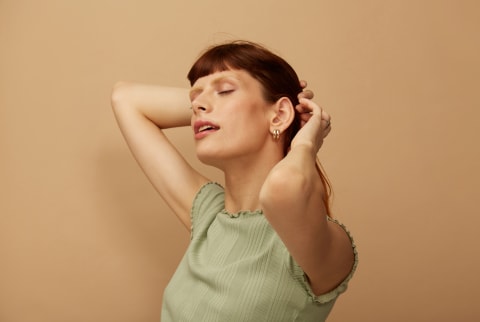Advertisement
3 Quick + Easy Ways To Massage Your Scalp & Stimulate Hair Growth


Looking to encourage thick, luscious locks? Hair growth serums are a great place to start, especially those with antioxidants, peptides, and botanical oils. So if you don't have one on hand yet, feel free to browse this list of tried-and-true growth serums.
Step No. 2 is working those serums into the scalp. As certified trichologist and hair expert Shab Reslan recently told mbg, "Circulation is everything," when it comes to scalp care. Her go-to method to increase circulation and boost hair growth: scalp massage. Ahead, find three different ways to add this step to your routine:
Invest in a scalp massager
If you want your scalp massage ritual to be quick and efficient, then a scalp massager is your best bet. These little tools can even be used in the shower to help slough off dead skin and product buildup.
In the shower, simply apply your shampoo, work it through your scalp, and then go in with the scalp massager. Be sure to invest in a gentle tool—no harsh plastic spikes allowed. Reslan's go-to: The Tangle Teezer Scalp Exfoliator and Massager.
Use your hands for a DIY experience
Massaging the scalp is not a new practice by any means, especially with a hands-on technique. This has been a significant and meaningful part of self-care routines in India for centuries, serving as a spiritual ritual as well (it's way more than just a hair growth hack).
The general scalp massage process isn't too complicated, however, and it's highly customizable. Simply take your fingers (not your nails) and apply medium-firm pressure to your scalp. Move your fingers in circular motions and continue to switch up the position until you give your entire scalp some TLC. Feel free to part your hair as needed to get deep down into the scalp.
Use a scalp serum or hair oil to keep the area moisturized while you massage. Afterward, leave in the product for a few hours to let your scalp soak up the nutrients, or you can rinse it out in the shower (your choice).
Opt for a gua sha comb
A third option is to use a gua sha comb on the scalp. Simply put, these are wide-tooth combs made from different stones like jade, rose quartz, and obsidian, for example. Gua sha originated in traditional Chinese medicine (TCM) and has been used for ages as a healing modality, but the practice has made its way stateside over time. The comb shape, in particular, provides an easy way to use those healing techniques on the scalp.
To use a gua sha comb, place it at the front of the hairline and comb backward. Typically, gua shas should be held almost flat to the head, with a 15-degree angle upward to create pressure. Like other massage methods, it's best to use your gua sha comb with a scalp serum or oil to avoid dragging on dry skin. Not sure where to find one? Shop our top pick: the Lanshin Jade Scalp Stimulator. Sandra Lanshin Chiu, L.Ac., MSTCM, acupuncturist, TCM practitioner, and founder of the brand, even has a helpful video with step-by-step instructions, if you'd like a visual.
The takeaway
Hair growth serums are a worthy step in any hair care routine. However, working them into the scalp via massage is one way to level up your scalp care regimen and encourage hair growth.
All three of these techniques will help stimulate circulation—in addition to just feeling great on the skin. If you want to learn more about scalp care 101, check out this breakdown.